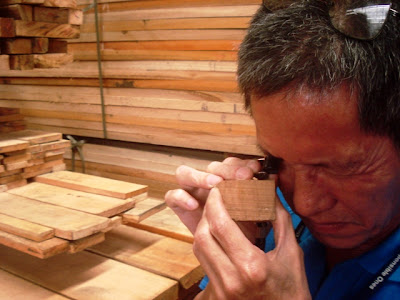WOOD IDENTIFICATION is the process of
determining the correct identity of a wood material based on its macro and
micro anatomical characteristics (Escobin 2012). It is especially useful in the
construction, builders’ wood works, furniture, and handicraft sectors that
require the correct identity of a wood material for their specific end-uses and
applications.
In
the Philippines, the Forest Products Research and Development Institute (FPRDI)
has been providing this service for almost five decades already. This is made
possible thru the Institute’s technical expertise and wood library, which hosts
16,348 specimens of Philippine and 5,274 foreign woods.
SELECTED
CLIENTS OF FPRDI’s WOOD IDENTIFICATION SERVICE
The historic Aguinaldo Shrine in Kawit, Cavite
houses many wood species that have been previously undocumented. Thru a
collaboration with the local government of Kawit, Cavite, Department of Science
and Technology Region IV-A, and Ecosystems Research and Development Bureau,
FPRDI experts identified on-site the wood species in the Shrine.
A
total of 177 pieces of antique furniture and woodcraft from the Shrine’s 10
rooms and three halls were inspected.These were found to be made from 16 wood
species such as narra and kamagong. A few were of non-wood species such as tree
fern used as ceiling and post ornaments, and rattan as “solehiyas” and whole
furniture. Foreign wood species were also identified from presumably imported
furniture.
FPRDI’s
wood anatomists were also commissioned to identify the species of the wooden
antiques and religious images displayed at the San Agustin Church’s PAGREL
Museum in Intramuros, Manila. Once identified, the wood items can be better
appreciated by enthusiasts and antique collectors visiting the church,
according to Forester Arsenio B. Ella.
Built
in 1571, the San Agustin Church is the oldest stone church in the Philippines.
It was declared as a UNESCO World Heritage Site in 1993. A total of 60 statues
were identified, with principal species belonging to molave (Vitex parviflora
Juss.), kamagong (Diospyros spp.), batikuling (Litsea leytensis Merr.), narra
(Pterocarpus indicus Willd.), makaasim (Syzygium spp.), santol [Sandoricum
koetjape (Burm. f.) Merr.], maranggo [Azadirachta excelsa (Jack) Jacobs],
kamatog [Sympetalandra densiflora (Elmer) v. Steen.], among others.
FPRDI’s
wood identification service has also been instrumental in pursuing legal cases
against illegal logging operators in the country. FPRDI experts have been tapped
by the Department of Environment and Natural Resources (DENR) to verify if the
lumber species seized at the Manila North Harbor come from natural/residual
forests or plantations.
Executive
Order No. 23 strictly bans cutting and harvesting of all trees in natural and
residual forests; only trees grown in industrial plantations may be harvested.
It mandates the DENR to lead the anti-logging campaign, togetherwith FPRDI,
Armed Forces of the Philippines, National Bureau of Investigation- Department
of Justice (NBI-DOJ), and Bureau of Customs.
The
Institute’s reports serve as evidences in court when DENR files charges against
illegal loggers and ship owners that transport the confiscated lumbers.
In
addition, the country’s maritime industry benefits from the wood identification
service. The MBB Marinewealth Industrial Corp., a Manila-based maker of
steamship bearings, had samples of Lignum vitae (known as iron wood)
authenticated by FPRDI’s wood anatomists. Lignum vitae, said to be the hardest
and heaviest wood in the world, has great strength that makes it fit for tube
bearings used in steamship engines. It also produces a special kind of
lubricant that renders it a preferred material for underwater use.
Thus,
the company can assure its clients that it uses genuine Lignum vitae for a
particular set of tube bearings, which is critical in maintaining the company’s
credibility (Escobin 2012). ### (Apple Jean C. Martin and Maybell Mariella A.
Amador, 03 May 2013)
